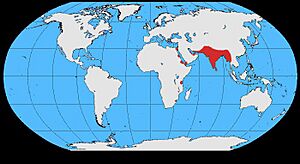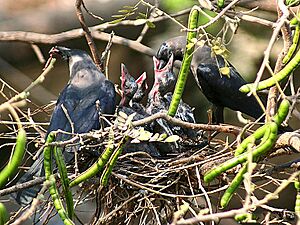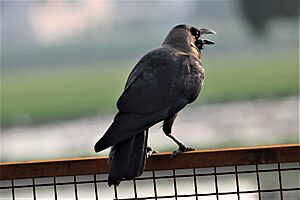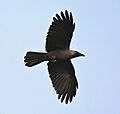House crow facts for kids
Quick facts for kids House crow |
|
|---|---|
 |
|
| C. s. insolens eating in Kuala Lumpur, Malaysia | |
| Conservation status | |
| Scientific classification | |
| Genus: |
Corvus
|
| Species: |
splendens
|
 |
|
The house crow (Corvus splendens) is a very common bird from the crow family. It's also known by names like the Indian crow or Colombo crow. These clever birds originally came from Asia. Now, you can find them in many parts of the world. They often travel to new places by hitching rides on ships!
House crows are about 40 cm (16 in) long. This makes them bigger than a jackdaw but smaller than a carrion crow. They are also a bit slimmer. Their forehead, the top of their head, throat, and upper chest are shiny black. Their neck and lower chest are a lighter grey-brown. Their wings, tail, and legs are black.
Contents
What are the different types of House Crows?
There are a few different types, or subspecies, of house crows. Each type looks a little different, especially around their neck.
- The C. s. splendens type lives in Pakistan, India, Nepal, and Bangladesh. It has a grey collar around its neck.
- The C. s. zugmayeri type lives in dry parts of South Asia and Iran. Its neck collar is very pale.
- The C. s. protegatus type is found in southern India, the Maldives, and Sri Lanka. This one has a darker grey neck.
- The C. s. insolens type lives in Myanmar. This is the darkest type and doesn't have a grey collar at all.
Where do House Crows live?
House crows live in many places across southern Asia. They are native to countries like Nepal, Bangladesh, India, Pakistan, Sri Lanka, and the Maldives. You can also find them in southern Myanmar, southern Thailand, and coastal southern Iran.
These birds have spread to other parts of the world too. They arrived in East Africa around Zanzibar and Port Sudan over a hundred years ago. They even reached Australia by ship, but those populations were removed. More recently, they have started breeding in Europe, like in the Dutch town of Hook of Holland since 1998.
You might also spot them in places like Hong Kong, where a group of 200 to 400 birds lives. A single house crow was even seen in Ireland in 2010! In the New World, a small group lives near St. Petersburg, Florida. House crows love to live near people, from small villages to big cities. This is because human areas offer them lots of food.
Why are House Crows considered an invasive species?
House crows are known as an "invasive species" in many tropical areas. This means they can spread quickly and harm the local environment. They are very good at finding food and adapting to new places. They almost always live near humans, as they rely on us for food and shelter.
Because they can spread so easily, the European Union added the house crow to its List of Invasive Alien Species of Union concern in 2016. This list helps countries manage species that could cause problems. While they have a breeding population in the Netherlands, individual birds have also been seen in Belgium, Hungary, Poland, and Spain.
How do House Crows behave?
What do House Crows eat?
House crows are very flexible eaters, which means they can eat almost anything! They mostly feed on trash and leftover food found near human homes. They also eat small reptiles, small mammals, and insects. Their diet includes eggs, baby birds, grains, and fruits. Sometimes, they even swoop down to snatch baby squirrels!
They usually find their food on the ground, but they will also look for it in trees. You can often see them near markets and garbage dumps, searching for scraps.
House Crow reproduction and nesting
House crows need trees to build their nests and raise their young. Sometimes, they even build nests on telephone towers! They usually lay 3 to 5 eggs in a nest made of sticks. You might even see several nests in the same tree. In South Asia, another bird called the Asian koel sometimes lays its eggs in house crow nests, tricking the crows into raising their chicks. House crows usually lay their eggs between April and July. They prefer to build nests in large trees with wide, leafy tops.
Where do House Crows sleep?
House crows often sleep together in large groups, called roosts. They like to roost near human homes, often over busy streets. Studies have shown they prefer well-lit areas with lots of human activity. These spots are usually close to food sources and in tall trees with thick leaves. Before flying to their sleeping trees, crows often gather on TV antennas, rooftops, or other trees. They might feed or clean themselves during this time.
What does a House Crow sound like?
The house crow makes a loud, harsh sound that sounds like kaaw-kaaw.
House Crows and human health
Scientists study house crows to understand how they might affect human health. Like many animals that live close to people, they can sometimes carry tiny germs. For example, some studies have looked at whether house crows might carry certain viruses that can affect other birds. They have also been found to carry a type of fungus that can sometimes cause problems for humans. However, these are rare cases, and scientists continue to learn more about how different animals interact with their environment and with people.
Images for kids
-
Sleeping at night in Kolkata, West Bengal, India.
-
House Crow in Chennai, Tamil Nadu, India

















